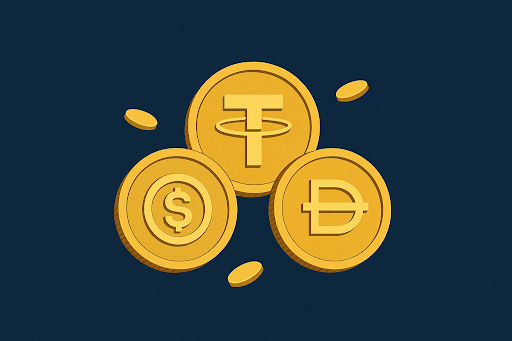Cryptocurrency is a high-risk asset class, and investing carries significant risk, including the potential loss of some or all of your investment. The information on this website is provided for informational and educational purposes only and does not constitute financial, investment, or trading advice. For more details, please read our editorial policy.
Best Crypto to Buy Now as Investors Turn to Stablecoins for Safety
15.04.2025 17:24 8 min. read Nikolay KolevWe may earn commissions from affiliate links or include sponsored content, clearly labeled as such. These partnerships do not influence our editorial independence or the accuracy of our reporting. By continuing to use the site you agree to our terms and conditions and privacy policy.

As the tariff wars keep tightening inflow of funds into various global markets, there seems to be a new safe haven investment that investors prefer — stablecoins.
This publication is sponsored. CryptoDnes does not endorse and is not responsible for the content, accuracy, quality, advertising, products or other materials on this page.
While the norm is for most to shift to conservative and more stable options like gold, the trend seems to be slightly shifting now, with a majority of investors seeking leading stablecoins as their hedge against inflation and the highly volatile money markets.
The new development sheds light on the US dollar’s weakening strength, but at the same time highlights how the adoption for blockchain tech has now gone beyond just investing in companies with utility products.
Stablecoins vs. Gold – A Shift in Investor Psychology
As global markets reel under the pressure of intensifying trade restrictions and erratic policy moves, investors are not running to gold with the same urgency as before. Instead, a significant number are parking their capital in digital dollars—stablecoins backed by fiat currency or ultra-liquid assets.
This quiet but decisive movement is revealing something profound: trust in the old safe havens is waning, and confidence in blockchain-based alternatives is rising.

During the most recent $6.4 trillion stock market meltdown, gold faltered—its price declined even as equities crumbled, breaking from its long-standing role as the universal hedge. The US dollar, too, slipped against the Swiss franc, signaling that even reserve currencies are now being questioned.
Meanwhile, stablecoins held their ground. Tether’s market capitalization alone surged to $144 billion, and the total stablecoin sector swelled to over $230 billion—a 56% year-over-year increase.
What makes this remarkable is that stablecoins are not backed by sentiment or tradition. Their strength lies in algorithmic precision, transparent collateralization, and an architecture that resists central manipulation. With new SEC guidelines now clarifying the regulatory standing of fiat-backed stablecoins, the perception of crypto is rapidly evolving—from speculative gamble to financial infrastructure.
This shift doesn’t just reflect changing preferences—it reinforces blockchain’s legitimacy. Stablecoins are becoming the new barometer of investor trust, marking a pivotal moment where crypto doesn’t just survive a crisis—it becomes the safe zone in one.
Best Crypto to Buy Now as Stablecoins Record Increasing Demand
SUBBD – ($SUBBD)
As investors shift capital into stablecoins, they’re signaling something louder than caution—an appetite for digital ecosystems with structure, transparency, and purpose. That’s the undercurrent powering projects like SUBBD, which doesn’t just sit on the sidelines of this change but aligns itself with what’s next for money and media.

SUBBD developers claim that it isn’t here to follow the influencer economy but to rewrite it. Built to challenge the one-sided profit dynamics of platforms like OnlyFans, SUBBD empowers creators with blockchain infrastructure that removes the middleman—and the 70% cut that comes with it. Fans gain direct access, real ownership of experiences, and token-based interactions that don’t vanish when a subscription expires.
What makes SUBBD relevant in the context of stablecoin preference is this: both are designed for trust. Where stablecoins guarantee value preservation, SUBBD guarantees economic autonomy. The creator is the bank, the platform, and the product—all secured on-chain.
As stablecoins demonstrate that blockchain-based tools can function reliably amid macroeconomic instability, it becomes easier to see SUBBD not as a rebellion against centralized media—but as the natural extension of a world learning to trust digital rails.
New milestone unlocked! 🔥
More than $150,000 raised in the $SUBBD token presale!
👉 https://t.co/dLCKejq5eX pic.twitter.com/l6zUyvrvaq
— SUBBD (@SUBBDofficial) April 12, 2025
In this new financial architecture, tokens like $SUBBD don’t need hype—they gain relevance by fitting the mold of what modern money and ownership should look like.
MIND of Pepe – ($MIND)
The growing tilt toward stablecoins isn’t just about value preservation. It’s also about better data, quicker execution, and smarter decision-making. MIND of Pepe rides that same wavelength—built not to store value, but to interpret where it’s heading.

On a first glance, it may look like another meme-driven project. But beneath the surface, it’s a neural engine tracking online conversations, filtering real-time sentiment, and flagging tokens that are gaining traction before they reach mass awareness. That’s critical in a market where narratives shape price as much as fundamentals.
So where does MIND of Pepe sit in the broader turn toward blockchain trust? Think of it as the intelligence layer. While stablecoins offer a quiet harbor in turbulent times, MIND of Pepe gives users a telescope to read the skies. It doesn’t offer a peg or a payout—it offers precision.
99Bitcoins, one of the biggest crypto education entities in the world, dubbed the project a potential top gainer in one of their featured videos on YouTube. Investors embracing stablecoins are no longer in it for thrill-seeking—they’re looking for systems that make sense. Its presale raise of more than $8 million proves this.
MIND of Pepe complements its theme by helping users identify patterns, whether it’s a capital migration or a meme wave, before it’s headline material. And its token isn’t just a ticket to entertainment—it’s access to an AI-fed dashboard that could very well serve as the next-gen Bloomberg terminal for meme-fueled markets.
In a world finally realizing the practical upside of crypto tech, MIND of Pepe is a timely reminder that sometimes, the loudest signals are wrapped in jokes—but decoded with algorithms.
BTC Bull – ($BTCBULL)
As the appeal of stablecoins grows stronger, one thing becomes clear—investors are now valuing structure over speculation. That’s exactly the kind of clarity BTC Bull was built around. It’s not here to reinvent the story of Bitcoin. It’s here to reinforce it, through a token that rewards belief with milestones, not marketing.

BTC Bull doesn’t dangle complicated tokenomics or yield promises. Its entire premise is simple: support Bitcoin’s rise, and in return, receive airdrops at each major price milestone. The idea flips conventional crypto design on its head—no need for arbitrary utility when the mission is tethered to the most recognized digital asset on the planet.
What ties BTC Bull to the current wave of stablecoin adoption is this: both are rooted in predictability. Investors are tired of surprises—they want frameworks. BTC Bull provides one. Every time Bitcoin hits a defined threshold, holders get rewarded, either through inflated price thanks to token burns or free Bitcoins. No staking, no games, just a supply-driven mechanism that mirrors the value of long-term conviction.
As stablecoins show the world that crypto can operate with discipline and precision, BTC Bull extends that same thinking into the speculative layer—giving investors something rare in the meme coin space: a roadmap that respects math over hype. In times like these, that’s not just refreshing—it’s exactly what people are looking for.
Solaxy – ($SOLX)
The stablecoin preference we’re seeing today isn’t random—it’s a signal that users want financial infrastructure that behaves predictably, moves quickly, and scales without compromise. Solaxy doesn’t just meet that criteria—it operationalizes it, serving as the connective tissue between Ethereum’s security features and Solana’s speed.

Solaxy is a Layer 2 protocol designed to optimize how transactions occur across these two ecosystems, especially Solana. But it’s not just another bridge—it brings staking, reward cycles, and more meme coins so that the Solana could thrive even more. That alone places it squarely in the category of crypto tools that thrive when demand for reliable systems spikes.
So why does this matter now, as stablecoins become the default refuge during market chaos? Because Solaxy operates on the same principle: dependability. While stablecoins ensure value retention, Solaxy ensures that transactional flow on Solana doesn’t choke when the markets get congested.
And with its presale drawing major attention as one of the biggest ones this season, Solaxy reflects a broader shift—one where crypto isn’t just seen as a hedge or a bet, but as infrastructure worth building on.
The $SOLX spaceship is picking up speed! 🛸🪐
30M Raised! 🔥🔥 pic.twitter.com/qvrYUwt2Sy
— SOLAXY (@SOLAXYTOKEN) April 14, 2025
When capital moves into stablecoins, it’s often a prelude to capital moving into systems that support them. Investors and the community as a whole believe that Solaxy could be that backend system.
Conclusion
As investors re-evaluate what “safe” truly means, the surge in stablecoin usage isn’t just about sheltering value—it’s about embracing systems built to endure. Projects like SUBBD, MIND of Pepe, BTC Bull, and Solaxy each reflect a different aspect of that evolution—utility, insight, conviction, and infrastructure. Together, they represent the direction in which digital finance is headed.
If stablecoins are the entry point, these tokens may well be what keeps investors engaged when the storm passes, making them assets worth watching out for.
This publication is sponsored. CryptoDnes does not endorse and is not responsible for the content, accuracy, quality, advertising, products or other materials on this page. Readers should do their own research before taking any action related to cryptocurrencies. CryptoDnes shall not be liable, directly or indirectly, for any damage or loss caused or alleged to be caused by or in connection with use of or reliance on any content, goods or services mentioned.
-
1
Best Crypto to Buy Now With Investor Eyes Back on Ethereum
08.06.2025 20:41 9 min. read -
2
Best Crypto to Buy Now as Singapore Bars Foreign-Only Digital Token Services
07.06.2025 20:55 7 min. read -
3
Snorter Token Raises $1 Million in Viral Solana Presale: Next 10x Crypto?
15.06.2025 3:08 5 min. read -
4
Best Crypto to Buy Now as Romania’s Post Office Embraces Bitcoin
06.06.2025 23:20 8 min. read -
5
Best Crypto to Buy Now as Lawmakers Clash Over Trump’s Blockchain Ties
05.06.2025 14:28 8 min. read
Best Meme Coins to Buy for 1000x Gains This June
Despite concerning turbulence across the global financial markets, the Web3 space is entering summer with some powerfully bullish undercurrents. Bitcoin (BTC) continues to trade above the $103,000 level, weathering a nearly 5% pullback that began last week, while Ethereum (ETH) remains in a long-term uptrend following multiple attempts at breaking its $2,750 resistance line. US […]
Best Crypto to Buy Now as Canada Spot XRP ETF Unlocks New Capital Inflows
Canadian regulators opened the door for two new XRP exchange-traded funds, granting final approval on June 16 and kicking off trading on the Toronto Stock Exchange on Wednesday, June 18. This publication is sponsored. CryptoDnes does not endorse and is not responsible for the content, accuracy, quality, advertising, products or other materials on this page. […]
Best Crypto Presales to Buy for 1000x Gains This Year
Bitcoin’s (BTC) price continues to show resilience above the $102,500 mark, reaffirming investor and corporate confidence in this quarter’s bullish uptrend. In a groundbreaking move, Trump Media & Technology Group has applied to launch an ETF that includes BTC and Ether (ETH), aiming for roughly a 75/25 allocation (75% BTC, 25% ETH), with Crypto.com lined […]
Best Crypto to Buy Now as Metaplanet Overtakes Coinbase’s Bitcoin Stash
Tokyo-based investment firm Metaplanet made headlines on June 16, 2025, by purchasing 1,112 BTC for around $117.2 million. This move pushed its treasury past the 10,000-coin milestone and placed it ahead of Coinbase on the list of public holders. *Metaplanet Acquires Additional 1,112 $BTC, Total Holdings Reach 10,000 BTC* pic.twitter.com/XlM13kQnS9 — Metaplanet Inc. (@Metaplanet_JP) June […]
-
1
Best Crypto to Buy Now With Investor Eyes Back on Ethereum
08.06.2025 20:41 9 min. read -
2
Best Crypto to Buy Now as Singapore Bars Foreign-Only Digital Token Services
07.06.2025 20:55 7 min. read -
3
Snorter Token Raises $1 Million in Viral Solana Presale: Next 10x Crypto?
15.06.2025 3:08 5 min. read -
4
Best Crypto to Buy Now as Romania’s Post Office Embraces Bitcoin
06.06.2025 23:20 8 min. read -
5
Best Crypto to Buy Now as Lawmakers Clash Over Trump’s Blockchain Ties
05.06.2025 14:28 8 min. read

